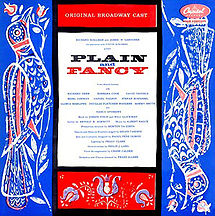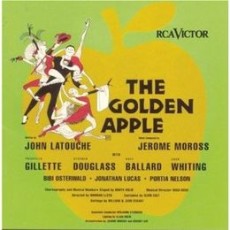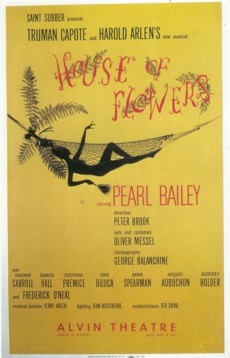
From Broadway To 52nd Street
Plain And Fancy opened at the Mark Hellinger Theatre on January 27, 1955 and ran for 461 performances. Albert Hague & Arnold B. Horwitt composed the music and the show starred Richard Derr, Shirl Conway, Will Able, Gloria Marlowe, Fletcher Rodgers and Barbara Cook. Bea Arthur was an understudy and Carol Lawrence was in the chorus. A favorite jazz tunes came from this musical was Young And Foolish.
The Story: New York City sophisticates Dan King and Ruth Winters travel to Bird-In-Hand in the Amish country of Lancaster County, PA to sell a piece of property to Jacob Yoder, who in turn intends to present it to his daughter Katie and her intended Ezra as a wedding gift. While there, they become involved with local villagers, including Hilda Miller, who mistakes Dan’s kindness for romantic overtures. Ezra’s banished brother Peter returns to claim the hand of his childhood sweetheart, Katie.
Broadway History: Previously, regardless of the size of the venue, a theatre was not considered Off-Broadway if it was within the “Broadway Box” (extending from 40th to 54th Street, and from west of Sixth Avenue to east of 8th Avenue, and including Times Square and 42nd Street. The contractual definition changed this to encompass theatres meeting the standard, which is beneficial to these theatres because of the lower minimum required salary for Actors’ Equity performers at Off-Broadway theatres as compared with the salary requirements of the union for Broadway theatres. Examples of Off-Broadway theatres within the Broadway Box are the Laura Pels Theatre and the Snapple Theater Center..
A number of Off-Broadway musicals have had subsequent runs on Broadway. These have included musicals such as Hair, Godspell, A Chorus Line, Little Shop of Horrors, Rent and The 25th Annual Putnam County Spelling Bee to name a few. Other productions such as Stomp, Blue Man Group and Altar Boyz have run for several years Off Broadway. The Fantasticks, the longest running musical in theatre history, spent its original 42-year run Off Broadway.
Sponsored By
www.whatissuitetabu.com

From Broadway To 52nd Street
The Pajama Game drew back the first curtain at the St. James Theatre on May 13, 1954 and ran a record 1063 performances catapulting the show into the register of blockbuster musicals. Eddie Foy Jr., John Raitt, Janis Paige and Shirley MacLaine starred in the musical with music written and composed by Richard Adler & Jerry Ross. Jazz has had the privilege to give the song Hey There perpetual encores.
The Story: Adapted from the Broadway play, it’s a story of Sid, a workshop superintendent who must deal with a union demand for a 7.5-cent raise at the Sleep-Tite Pajama Factory. A strike is imminent and Babe the leader of the grievance committee leads the fight. However Sid is attracted to Babe and ensues a course of romance but is deflected. With slowdowns and machinery breakdowns promoting her cause, Sid reluctantly fires her. However he is convinced there is merit to Babe’s championship of the union and plots to get a peek at the books kept by Gladys.
Taking Gladys out to a nightclub Sid wheedles the keys from her but before he can leave the two are discovered by Babe. Sid gets a look at the books, sees that the boss has already tack on the 71/2 cents to production but has keeping the profits for himself. Sid confronts the boss, gets him to agree to the raise, goes to the union rally to bring the news and peace to his love life. Finally accepting her feelings for Sid, she falls for him. Everyone goes out to celebrate at Hernando’s Hideaway.
Jazz History: The free jazz movement, coming to prominence in the late ’50s, spawned very few standards. Free jazz’s unorthodox structures and performance techniques are not as amenable to transcription as other jazz styles. However, “Lonely Woman”, a blues by saxophonist Ornette Coleman, is perhaps the closest thing to a standard in free jazz, having been recorded by dozens of notable performers.
Free jazz is an approach to the music that was first developed in the 1950s and 1960s. Though the music produced by free jazz composers varied widely, the common feature was a dis-satisfaction with the limitations of bebop, hard bop and modal jazz, which had developed in the 1940s and 1950s. Each in their own way, free jazz musicians attempted to alter, extend, or break down the conventions of jazz, often by discarding hitherto invariable features chord changes or tempos. While usually considered experimental and avant-garde, free jazz has also oppositely been conceived as an attempt to return jazz to its “primitive”, often religious roots, and emphasis on collective improvisation.
Sponsored By
www.whatissuitetabu.com

From Broadway To 52nd Street
The Golden Apple was staged for it’s initial performance at the Phoenix Theatre on March 11, 1954 and ran for one hundred and seventy-three performances. The stars of the musical were Kay Ballard, Dean Michener, Jonathan Lucas, Jack Whiting, Stephen Douglass, Bibi Osterwald and Priscilla Gillette. Jerome Morross composed the music with libretto written by John Latouche and their composition Lazy Afternoon emerged from the musical to make the pantheon of jazz standards.
The Story: In a small turn-of-the-century American village called Angel’s Roost, nothing of importance seems to happen until a traveling salesman arrives at the annual fair in a balloon. He so beguiles the wife of the sheriff that she elopes with him to the neighboring town. The mayor throws roadblocks in the pursuer’s path. After the sheriff outclasses the salesman in a boxing match, he returns home to find love from another woman waiting for him. Recreation of Homer’s The Iliad & The Odyssey.
Broadway History: The Off-Broadway theatre is a professional New York City venue with a seating capacity between 100 and 499, much smaller than those on Broadway. An Off-Broadway production is a production of a play, musical or revue that appears in such a venue, and which adheres to related trade union and other contracts.
The Off-Broadway movement started in the 1950s, as a reaction to the “perceived commercialism of Broadway” and provided an “outlet for a new generation” of creative artists. This fertile breeding ground, away from the pressures of commercial production and critical brickbats, helped give a leg up to hundreds of future Broadway greats. The first great Off-Broadway musical was the 1954 revival of the Brecht/Weil Three Penny Opera.
Sponsored By
www.whatissuitetabu.com

From Broadway To 52nd Street
House Of Flowers opened at the Alvin Theatre on December 12, 1954 with music by Harold Arlen and lyrics and book by Truman Capote. This was his only Broadway musical based on his own short story, which was first published as one of three extra pieces in the Breakfast At Tiffany’s novella. Pearl Bailey, Diahann Carroll, Juanita Hall, Alvin Ailey, Geoffrey Holder, Ray Walston and Carmen de Lavallade starred for 165 performances. The composition that emerged from this musical to become a jazz standard was “A Sleepin’ Bee”.
The Story: During a trade war between two Haitian brothel keepers, Madame Tango and Madame Fleur, the latter sells one of her girls, Ottilia, to a rich lord. Ottilia turns him down preferring young, handsome but poor mountain boy Royal. and despite Fleur’s machinations to seal Royal in a barrel and toss him into the ocean, he escapes his watery grave on the back of a turtle. The lovers eventually marry and live happily ever after.
Jazz History: Hard bop, an extension of bebop (or “bop”) music that incorporates influences from rhythm and blues, gospel, and blues especially in the saxophone and piano playing, developed in the mid-1950s, partly in response to the vogue for cool jazz in the early 1950s. The hard bop style coalesced in 1953 and 1954, paralleling the rise of rhythm and blues. Miles Davis’ performance of “Walkin'”, the title track of his album of the same year, at the very first Newport Jazz Festival in 1954, announced the style to the jazz world. The quintet, Art Blakey and the Jazz Messengers featuring pianist Horace Silver and trumpeter Clifford Brown were leaders in the hard bop movement along with Davis.
Modal jazz recordings, such as Davis’ Kind of Blue became popular in the late 1950s. Popular modal standards include Davis’s “All Blues All” and “So What”, John Coltrane’s “Impressions” and Herbie Hancock’s “Maiden Voyage”. These recordings would eventually lead to the formation of Davis’ second great quintet, which included saxophonist Wayne Shorter and pianist Herbie Hancock, recorded a series of highly acclaimed albums in the mid-to-late 1960s.
Sponsored By
www.whatissuitetabu.com

From Broadway To 52nd Street
Our journey from Broadway to 52nd Street continues with Kismet that opened as a play on December 25, 1911 at the Knickerbocker Theatre and ran for 184 performances. However, it wasn’t until almost 42 years later to the day that it opened on Broadway as a musical on December 3, 1953. Two songs, Stranger In Paradise and Baubles, Bangles & Beads came from the musical composed by Robert Wright and George Forrest to become jazz standards. The musical ran for 583 performances with Ronald Coleman, Marlene Dietrich and Edward Arnold playing the musicals starring roles.
The Story: Haji, a wily beggar and poet is arrested on a minor infraction by the Wazir, who agrees to release him if he kills the Caliph. Hajj’s attempts fail and he is thrown in jail with his old enemy the sheik. He kills the sheik and escapes in his clothing. Learning his daughter is a concubine in the Wazir’s harem, Hajj drowns the Wazir and frees his daughter. The Caliph marries the daughter but by law must banish Hajj. When Hajj returns, the Caliph looks the other way and allows him to beg and recite poetry.
Broadway History: In the 1950s, Broadway musicals were a major part of American popular culture. Every season saw new stage musicals send songs to the top of the charts. Public demand, a booming economy and abundant creative talent kept Broadway hopping. To this day, the shows of the 1950s form the core of the musical theatre repertory. The best of these musicals integrated every element, offering recognizable characters singing in stories told with wit and genuine heart – in short, they applied the Rodgers & Hammerstein formula. The two songwriters were international celebrities, so the media treated each new Rodgers & Hammerstein stage show as a major event.
Oscar Hammerstein II died due to stomach cancer a few months after The Sound of Music opened, ending a career that spanned the golden age of musical theatre and film. After working with the innovative Jerome Kern Jerome and operetta master Sigmund Romberg, he did his finest work with Rodgers, and later coached young Stephen Sondheim. More than any other individual, Hammerstein had turned the once-innocuous Broadway musical into a potent dramatic form, and had turned lyrics into essential dramatic tools. He did it by being a superb storyteller and a dedicated craftsman. Even when dealing with serious issues, he always kept his focus on intriguing characters caught in remarkable situations.
Sponsored By
www.whatissuitetabu.com


